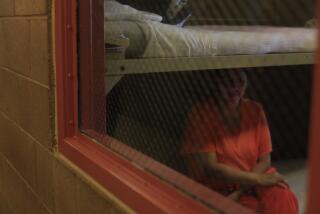CDC probing valley fever outbreaks in two California prisons
- Share via
SACRAMENTO — The national Centers for Disease Control and Prevention has stepped in to investigate outbreaks of valley fever in two California prisons where more than three dozen inmates have died after contracting the fungal disease.
Staff from the Atlanta-based CDC met with state prison health officials Tuesday and another meeting is planned Thursday. California’s health department formally asked for the assistance last week on behalf of a court-appointed monitor, who had previously requested repeatedly that state officials seek federal help.
The court receiver for prison healthcare, J. Clark Kelso, issued a directive this week that Avenal and Pleasant Valley state prisons relocate some 3,200 inmates deemed at increased risk of developing a fatal reaction to the fungus, including all African Americans and those over 55. On Wednesday, Kelso broadened his directive to also include inmates with certain forms of diabetes.
Corrections officials, who were given an advance copy of Kelso’s order two weeks ago, said they were still evaluating it. They said the directive complicates Gov. Jerry Brown’s effort to comply with orders from the same federal courts to reduce crowding in all 33 state prisons.
Brown’s plan for reducing prison crowding by 9,000 inmates to improve medical care throughout the system is due Thursday.
“Any decision to shift thousands of inmates based on race and age into other facilities must be weighed with the risks such a dramatic move would pose to public and institutional safety and to the delivery of healthcare system-wide,” corrections spokesman Jeffrey Callison said.
In a report to U.S. District Judge Thelton Henderson on Wednesday, Kelso accused the state of an “anemic response” to the rise in valley fever deaths, saying officials had done little beyond adding air filters and door seals to keep out fungus-tainted dust.
Six years ago, the receiver asked prison officials to transfer high-risk inmates out of the two lockups near Coalinga in the Central Valley and to consider relocating all inmates if valley fever rates did not drop. As of this week, some 500 high-risk inmates remained in the two prisons.
In his report Wednesday, Kelso included a health risk analysis that showed African American inmates in those prisons have a 90% increased risk of valley fever, Latino inmates had a 30% increased risk and those older than 55 had a 60% higher risk.
Zakiya Bell is worried that the state has endangered her son, an African American inmate serving time at Pleasant Valley. “They really don’t look at the prisoners as anything but lowlifes,” she said.
More to Read
Sign up for Essential California
The most important California stories and recommendations in your inbox every morning.
You may occasionally receive promotional content from the Los Angeles Times.











